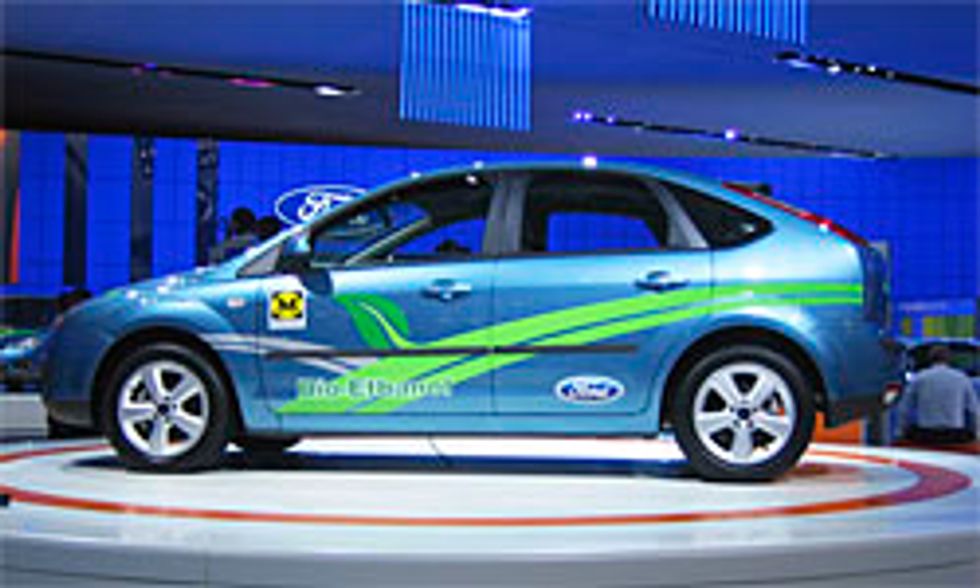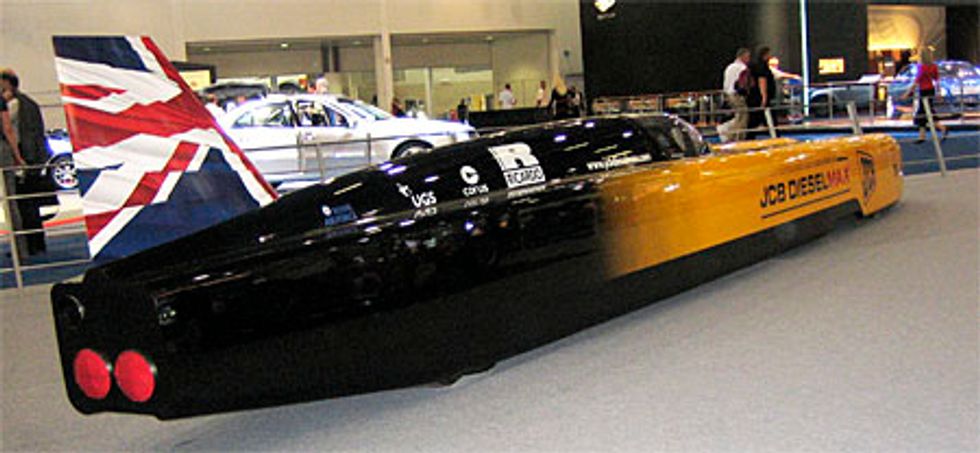Cars that run on diesel, ethanol, and pure electricity surround me, each a small step toward a future less dependent on fossil fuels. This technology alone sets the 2006 British International Motor Show a world apart from any U.S. show. So does the profusion of small hatchbacks--thrifty family cars never seen in North America. But some things automotive never change: I soon found the usual bevy of supercars, in which advanced materials and complex power trains are aimed solely at increasing speed, acceleration, and roadholding.
The Dog That Didn’t Bark
One of the more technically interesting concepts was Saab’s carbon-neutral BioPower Hybrid, an elegant silver-grey convertible—indeed, the first hybrid convertible ever. It’s based on the 9-3 BioPower model, sold in Sweden, which runs on 15 percent gasoline and 85 percent ethanol (E85), generated out of waste from the forestry industry. The advantage of that last point is seen in carbon bookkeeping: because trees suck carbon from the air, burning ethanol distilled from those trees adds no net carbon to the atmosphere. The BioPower burns 100 percent ethanol (E100), and therefore its carbon footprint is a perfect zero.
Martin Elliott, manager of hybrid-electric vehicle integration for GM-Europe, called the concept a ”learning project” that let Saab experiment with General Motors’ two-mode hybrid system (effectively two automatic transmissions, each with a 53-kilowatt electric motor). The engine, an aluminum 191-kW (260-horsepower) 2.0-liter turbocharged four, drives the front wheels. A 38-kW electric motor drives the rear wheels. The engine’s integrated 15-kW, 42-volt starter-generator adds its own power boost, and auxiliary functions—power steering, air conditioning, and lighting—are permanently powered by the battery, keeping the car functional when the engine shuts off. Power control logic for its parallel operation is as challenging as any, because it must recover, store, and feed back energy among an engine, a battery pack, and no fewer than four electric motors.
Saab fans on the Internet managed to obtain and post copies of an earlier press kit that described another feature Saab had not revealed: a plug-in recharging capacity for the car’s 42-cell 300-V lithium-Ion battery pack. This feature would greatly increase the 10- to 20-kilometer range of the car’s all-electric Zero Mode, which the driver can select for parking, short trips below 50 miles per hour (80 kilometers per hour), and the like. A 220-V socket was said to have been located behind the Saab badge on the trunk lid; GM has not commented on this recharging capacity.
If you net out the carbon trapped in plants grown to make its ethanol, Ford’s Flex-Fuel Focus has lower carbon emissions than a petroleum-fueled hybrid. If only Ford’s singing actors had skipped the appalling ”Bioethanol Rap.”
”Bioethanol Rap”
Ford of Europe announced that its Focus Flex-Fuel Vehicle (FFV) can have a lower carbon footprint than a gas-electric hybrid because its flexi-fuel power allows it to run on plant-derived ethanol.
Ford made this point via a youngish alt-fuels program manager, who answered staged, mock-saucy questions from a race- and gender-balanced group of teens, along the lines of, "Yo, so Ford is way last century, innit? Destroying the earth with carbon and all?" After the hapless exec reeled off the approved response (ethanol is good for the planet, because it lowers overall carbon emissions), the teens switched on approving eco-smiles and launched into the "bioethanol rap." Thankfully, it lasted only a few minutes. The English have a word for this sort of thing: cringeworthy.
Land Rover took more concrete action. It will reduce the carbon footprint of each of its vehicles by buying compensatory offsets of various types—planting trees, for instance. Such ”carbon trading” was enshrined in the Kyoto Treaty and has also been practiced voluntarily even in countries, like the United States, that haven’t ratified it. More radically, the company will charge UK customers a fee of £85 to £165—about US $160 to $310—to compensate for the first three years of their new vehicle’s carbon dioxide emissions. Land Rover forwards the funds to ClimateCare, a nonprofit company that invests in schemes that reduce or eliminate carbon. Does this lower the emissions of its vehicles? Absolutely not. But it’s a noteworthy line in the sand. Will Land Rover extend the program to other countries? The company was mum.
Golf Carts Gone Wild
London now has thousands of electric cars, due largely to the £8 ($15) daily congestion charge for entry into the city’s core. Electrics are exempt, as are certain hybrids. Now, small boxy e-cars are seen on the streets of very tony neighborhoods—parked next to cars like Porsches and Jaguars.
Three e-cars were announced. Most noteworthy was a full-electric version of the Smart ForTwo. Up to 200 Smarts will be modified in the UK, with a 30-kW motor and battery pack replacing the gasoline drivetrain. Thanks in part to regenerative braking, which recovers energy normally wasted on stopping a car and turns it back into juice you can use, the Smart has a range of 70 miles (112 km). Top speed is 70 mph (112 km/h), and it does the stoplight drag (0 to 30 mph, or 0 to 48 km/h) in a tolerable 6.5 seconds.
The other two cars, from specialty makers, were smaller and cruder. The NICE (”no internal combustion engine”) fiberglass two-seater, from France, has a tiny 4-kW motor that propels it to 40 mph (64 km/h), with up to 50 miles (80 km) of range from eight 6-V lead-acid batteries. The G-Wiz AC, another fiberglass two-seater, offers similar range and speed. Because the average urban trip is 10 miles or less, and the speed limit on London’s surface streets are 30 miles per hour, these cars will serve perfectly well for dropping off kids at school and the like.
The 22-Meter-Long, 300-mph Diesel
In Europe, where fuel costs a lot and fuel-economy ratings matter, more than half of all new cars are powered by diesel engines. Even Cadillac offers a 1.9-L 148-hp turbodiesel that gets 38 miles per gallon (6.1 liters per 100 kilometers) in its new BLS model; it’s the first Cadillac neither made nor sold in the United States.
At 22 meters (72 feet), the JCB Dieselmax was without a doubt the longest diesel car at the show-and, it turned out, the fastest. On August 23, it averaged 350.092mph (563.418km/h) over one mile, greatly exceeding a 33-year-old record for a diesel-powered vehicle.
The most exciting diesel was the JCB Dieselmax. This month, Royal Air Force Wing Commander Andy Green (a British media hero) will attempt to set a new diesel world speed record in it, hoping to exceed 300 mph (480 km/h), leaping past the 236-mph (380-km/h) record set 33 years ago. The 22-meter- (72-foot-) long single-seater is powered by two 750 brake horsepower (bhp) turbodiesel engines.
Before the show opened, a Mercedes-Benz SLR McLaren set another speed record, for a car driven (legally!) in London: 175.7 mph (282.8 km/h) on a runway at City Airport. The 478-kW (650-hp) SLR has a superlight body of carbon fiber, and it demonstrated not only extraordinary acceleration but the brakes necessary to scrub off all that speed and avoid ending up in the adjacent Thames River. The SLR and other supercars lured the crowds to a ”Dream Drive Paddock” with 30 of the world’s sleekest, fastest, most outrageous production cars from Ferarri, Lamborghini, Maserati, Noble, Saleen, and others.
Eccentric Morgan, which has built its 4/4 model for 70 years—yes, that’s 70—showed the Aero 8 that horrified traditionalists in 2002. No more sliding-pillar front suspension from 1910; no more ash framing for the body. Instead, it uses a thumping 242-kW (325-hp), 4.4-L BMW V8 engine in a modern, all-alloy frame with (somewhat more) aerodynamic bodywork. The result is 0 to 100 mph (161 km/h) in 11.0 seconds and a top speed of 160 mph (258 km/h).
Carmaker or Tech Start-up?
More forward-looking was the Connaught Type-D GT. This company is new, but it has applied the respected Connaught marque—known for 1950s’ Grand Prix success—to a technically unique luxury four-seater.
The designers’ goal was to build a high-performance 2+2 with best-in-class space, performance, and fuel efficiency. The £64 500 (US $122 000) coupe is powered by the company’s own tiny 2-L, supercharged 300-hp V10. Fabricated from laser-cut stainless steel with an aluminum body, it weighs just 950 kilograms (2100 pounds), hits 170 mph (274 km/h), and still delivers 18 mpg (12.8 L/100 km). Just 100 cars will be sold.
Next year’s hybrid Type-D will use lightweight supercapacitors—not heavy batteries—to provide a claimed 35 mpg (6.7 L/100 km), and a subsequent version adds cylinder deactivation to raise mileage to 50 mpg (4.7 L/100 km). As Connaught cofounder Tony Martindale said, ”In effect, you get a highly luxurious and spacious 1.0-L five-cylinder hybrid—exempt from the congestion charge.” Bold claims, for sure, but Connaught seems as much engineering start-up as car company. It holds 23 patents; only 17 are for automotive technology.
About the Author
John Voelcker covers auto technology for IEEE Spectrum, Popular Science, and other media. His automotive blog can be found on RoveSite.com. He is executive editor of ROVE and the founder of Profuse Media, a consultancy specializing in the interactive media business.

